
Yes, you read that correctly -- we spent 8 days at Colonial Williamsburg,
Virginia. In case you don't know, Williamsburg was the capitol of Virginia
in the 1770s. During the 1930s, Nelson Rockefeller started the Colonial
Williamsburg Foundation, which began buying up many original 18th century homes
and buildings in Williamsburg, with the goal of restoring them to their
condition in 1774. The purchase offer was quite generous: a large amount
of cash up front, and the promise that the family and its children could
continue to occupy the house for the rest of their natural lives, at which time
the house would become the property of the foundation. I believe that
there is still one such resident, living in the Payton Randolf home -- she is in
her 90s. The foundation owns 88 original 18th century buildings, many of them
restored and operating as exhibits of one sort or another in this living
museum. Most of the entirety of Williamsburg of 1774 is now under the
control of the foundation, so that they own a small core of the town, 1 mile
long by 1/2 mile wide, complete with homes, businesses, taverns and craftsmen,
all plying their trade as they did 225 years ago. It is fascinating.
In the pictures and photos below I shall attempt to give you a flavor of this
marvelous historical site, and why we loved it so much.
It began with the price: for $36 for adults and $18 for youths, you can see
everything Colonial Williamsburg has to offer, and come back every day, for an
entire year. This was one cheap date for us. We packed a lunch each
day, and breakfasted and dined at 'home' for the most part, so it was all
incredibly economical -- especially when compared to the Land of the Mouse.
Each day, in addition to all of the 'standing' attractions (which included
tours of homes and businesses, usually conducted by a person impersonating the
18th century owner), there were various programs occurring all over the
township: militia musters, court proceedings, the arrivals, speeches and
departures of various historical figures, etc. Our first day, Jody drew up
a personal schedule for us, to which we mostly adhered, that broke down our
chosen days activities. We were typically in Williamsburg from about 9:30
AM until 5ish, then quickly home for dinner, and back by 6:30 or 7:00 for
"Williamsburg by Night", a series of programs that included
candlelight tours, storytelling, small concerts, or the like. These
evening activities were only sparsely attended for whatever reason, so we
enjoyed them all the more.
The weather was mercifully cool, with daytime temperatures getting into the
low 70s by late afternoon, and cloudy most of the time. It threatened rain
often, but we got very little, and it never interfered with our plans.
The shot below is of a typical street scene, with Jordan also typically
unshod.
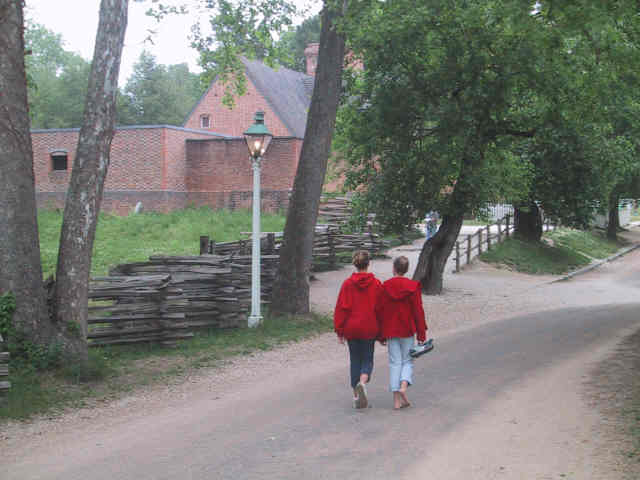
On our first day of touring, we took the "Gardens of Gentility"
walk, which was a bit esoteric for us, covering as it did how certain designs,
materials and plants conveyed one's station in life. But we did like to
look at the restored gardens, most all of them in full spring bloom.
However, it was a lot of walking early in the day, and the girls quickly
became pooped, although they did not complain. Jordan found a shady
bench inside of a beech arbor, and took her rest there for a time.
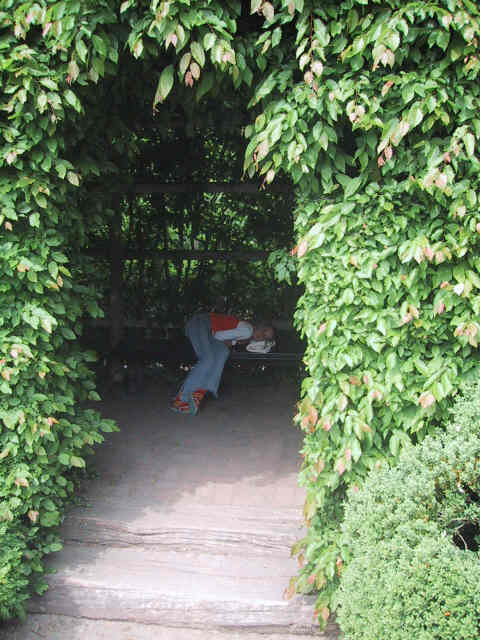
The single most marvelous thing about Colonial Williamsburg are its actors,
who "interpret" various historical figures. They often interact
with each other to re-enact events of the past, but they also interact with us
visitors, often by giving historically accurate speeches and then inviting
"queries and comments" from the audience. They do so
improvisationally, but clearly with great preparation, often speaking exact
phrases uttered by those they interpret. Our two favorites were George
Washington and Patrick Henry, below at left and right respectively. If you
have access to an encyclopedia or other research tool, compare this shot of the
21st century Patrick Henry to the original -- the resemblance is uncanny.
Also, the 21st century Mr. Henry more than ably reproduces the legendary fire
with which the 18th century Henry spoke; historians have labeled him the
"Voice of the Revolution".
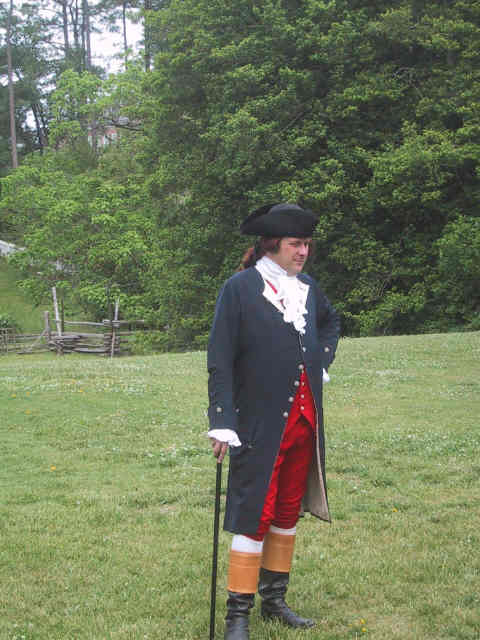
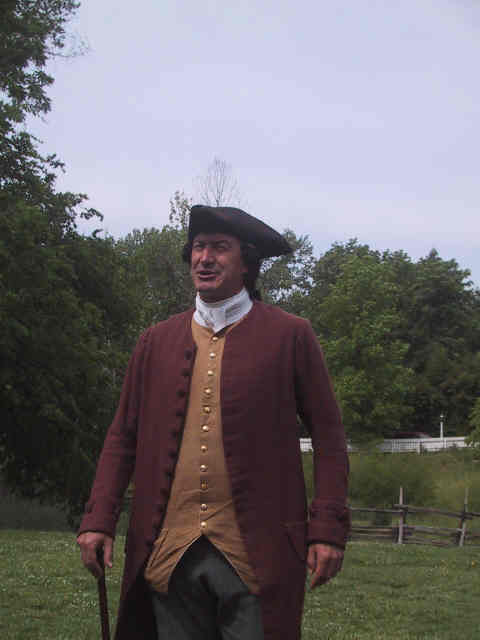
In addition to the dandies above, our own precious dandies tried on the
fashions of the times for the ladies, with amusing results.
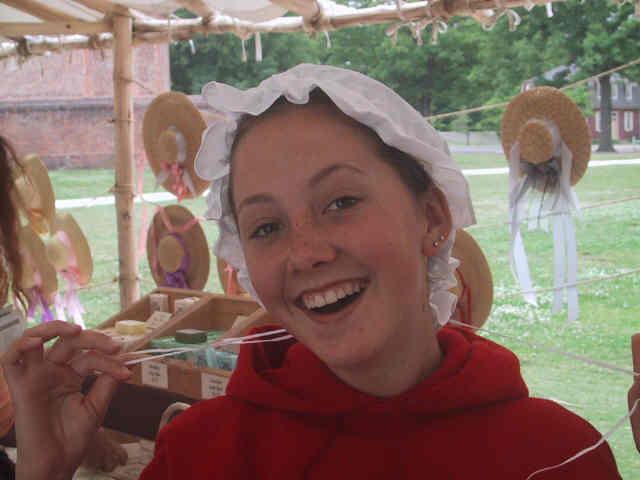
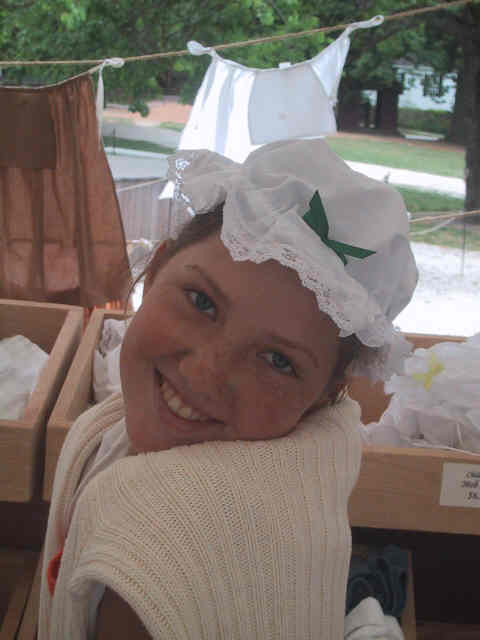
We took several different walking tours on single subjects: "Gardens
of Gentility", "Enslaving Virginia", "The Other Half",
"How to run an 18th Century Business", "Tavern Gardens", and
several others. Pictured below is Mr. Geddy demonstrating how to determine
the value of a part of a gold or silver coin (by weight only, of course --
nothing mattered besides how much silver or gold was actually present).
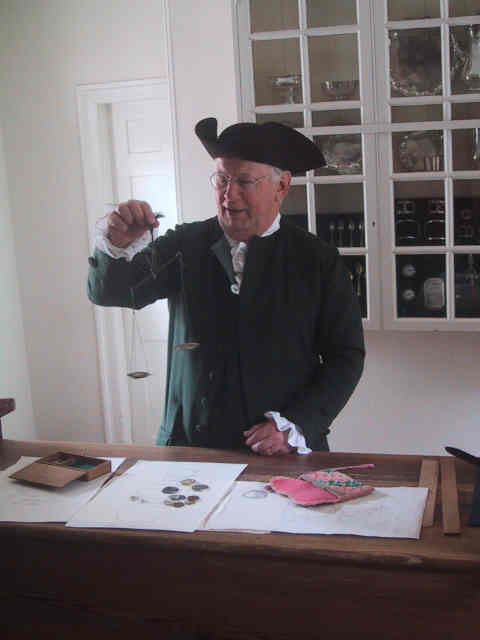
Behind Mr. Geddy the silversmith's was the foundry, where various implements
were made, often of pewter, since it was relatively inexpensive and melted
easily. The shot below is a processed black and white shot showing some of
the tools used by the foundryman.
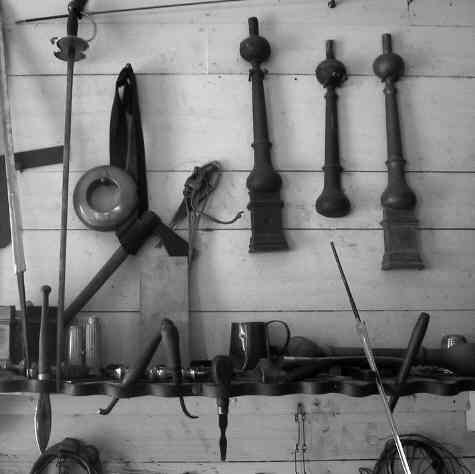
And, of course, the foundryman himself, casting pewter spoons. Since
this enterprise was begun by the Rockefellers, the spoons this man produced
are sold in the gift shops -- for 20 to 30 dollars each. We declined to
purchase any.
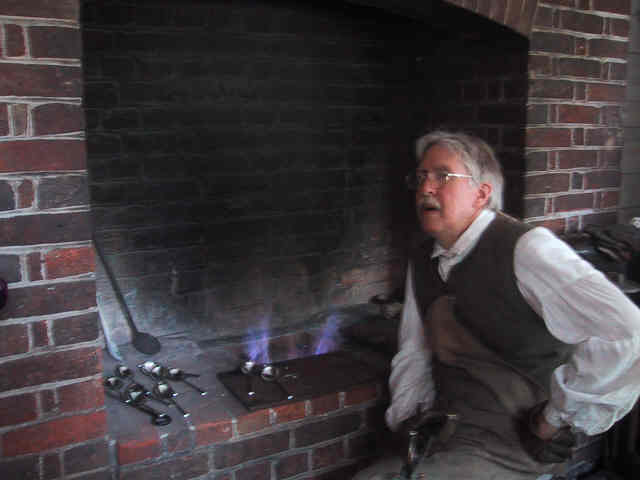
Another of our favorites was the tailor, pictured below. This man ate,
drank and breathed the tailor craft of the late 1700s, never for a second
stepping out of character. His accent was wondrous to listen to, and his
knowledge of his craft seemly endless. We visited him twice, the second
time just to be in the space of one so accurately (to our eyes and ears)
presenting a person of the past. On our second visit, we interrupted him
as he prepared his lunch of roasted squirrel and turnip greens. We believe
he actually ate that. While there, he inquired of the girls if they were
able to make me a proper shirt, since I seemed to be badly in need of one,
perhaps alluding the unwashed state of same.
When they said they could not, he chastised Jody for not teaching them adequate
housewifery skills, the most important of which was the learning of "one's
needles", which typically began at age 4 or so for 18th century children of
both sexes.
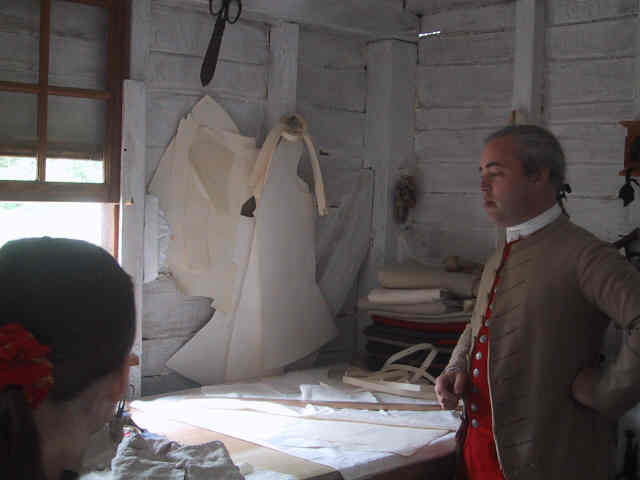
A common occurrence on the various greens and fields were musters of
militiamen, complete with fife and drum corps. We sat and watched as 4
squads of new 'recruits' (taken from the audience just then) were given wooden
rifles and taught basic marches, after which they were presented to the colonial
governor, who presented them with small tokens of his esteem -- parchment gift
certificates for goodies from the gift shops, I think.
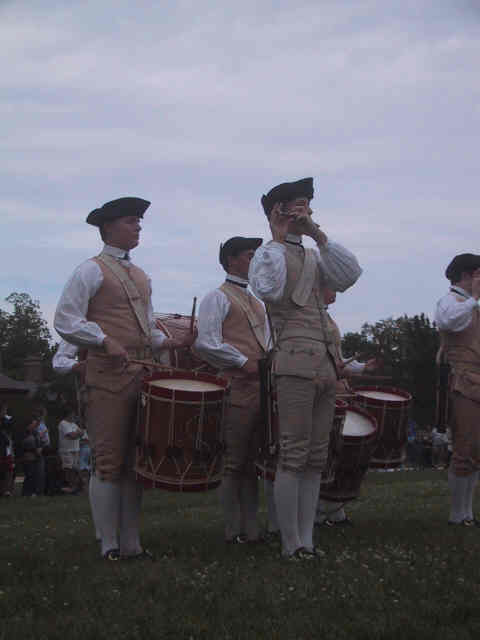
The governor's palace tour was very interesting. While not large, it
was nonetheless impressive. There were 7 or 8 hundred working rifles on
display in the parlors, hallways and stairway, as well as countless swords, like
those pictured below -- all designed to remind visitors that the governor was
the King's agent here in Virginia, and that he spoke on behalf of the King, and
with the force of the King.
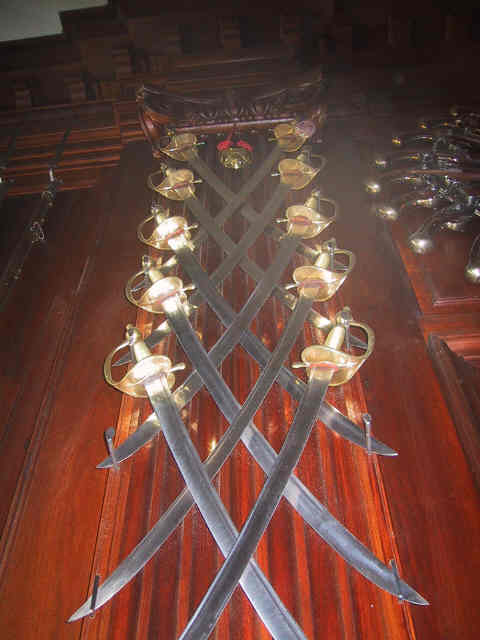
In the Wythe house, the girls were invited to learn to play a popular 18th
century card game similar to poker, but with simpler rules. Instead of
using 'chips' as betting tokens, this game used 'fish' -- not actual fish, of
course. Note that the cards did not have any numbers printed on them.
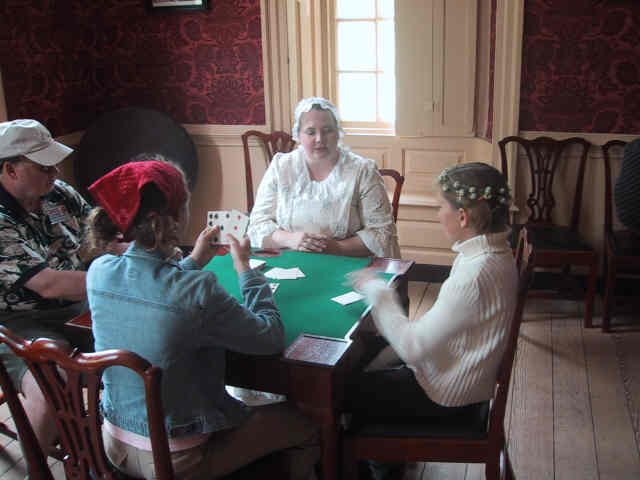
Some of the critical events of 1774 occurred in May of that year. In
December 1773, the people of Boston had expressed their displeasure with the
Townsend Acts and resulting taxes on tea by dumping hundreds of pounds of it
into Boston Harbor. In retaliation, in May of 1774, Lord North, King
George's "First Minister", ordered their harbor closed beginning in
June 1774. The Virginia House of Burgesses, which was the representative
colonial government presided over by Governor Lord Dunmore, passed a resolution calling for a day of "Fasting,
Humiliation and Prayer", since the harbor's closure would cause grave
hardships for the people of Boston. Lord North, King George and Governor
Dunmore felt this was overstepping their authority. Thus, below we see
Governor Dunmore and his aide arriving at the capitol to address the House of
Burgesses, and proclaim his displeasure. At Lord North's request, Governor
Dunmore actually disbanded the House of Burgesses, which closed the colonial
courts and gave them no operating government. It is estimated by some that
this was the plan all along, carefully crafted by the brilliant political minds
of the time -- that by forcing Lord North and Governor Dunmore to dissolve the
House of Burgesses, which kept several key pieces of legislation from being
passed, the stage was set for a war for full scale independence.
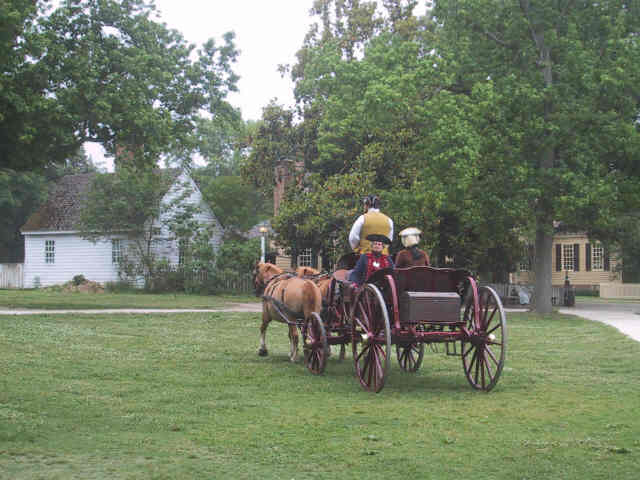
Later that same day (in the 21st century re-enactment), an effigy of Lord
North was tried, hanged, shot, burned and finally exploded. Tempers were
getting fierce, and anti-royal sentiment was growing by leaps and bounds.
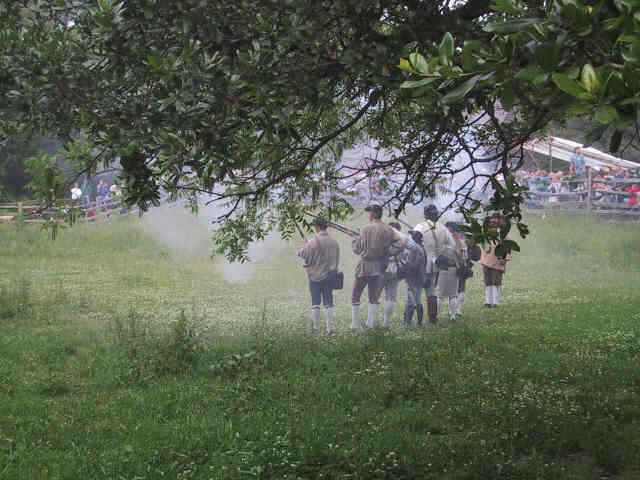
This is the fate that befell those convicted of misdemeanor crimes. All
felony convictions resulted in either death by hanging, or by the granting of
'mercy' and subsequent branding of
the palm.
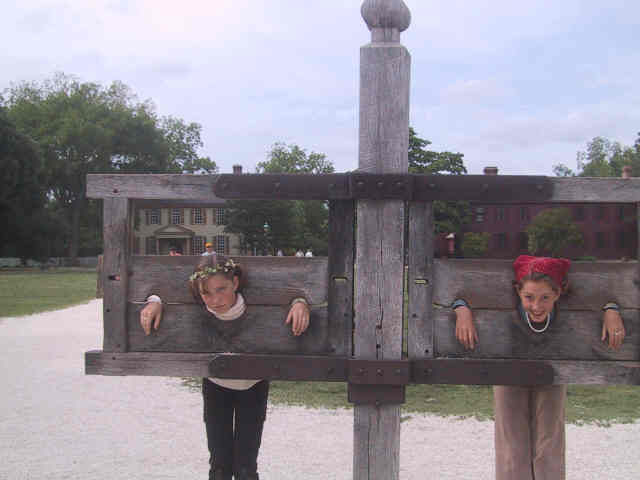
Roaming the streets and common areas were numerous members of the upper
working class -- "middling sorts" -- just plying their trade.
This man was showing off his ox team, and answering questions about them, their
habits, and capabilities.
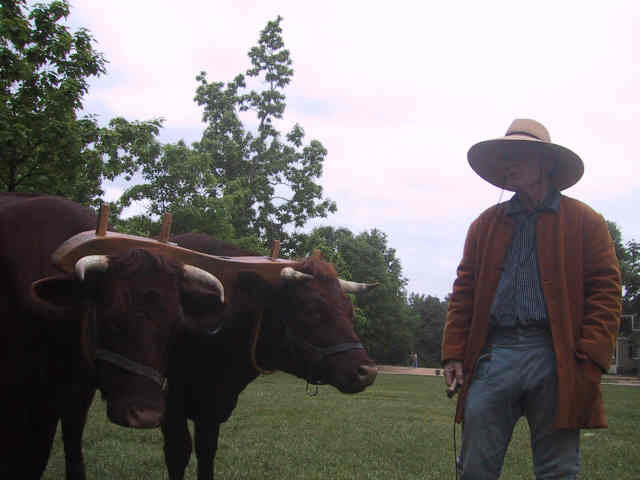
The woman pictured below was portraying a wealthy woman's cook, and was a
treat herself. Born in Ireland and still carrying that accent, she
described in great detail what was involved in the preparation of various
foodstuffs, including "Breaded Brain Balls" and "Roasted Calves
Head" (the jowls are reported to be especially yummy). They did not
waste any edible part of food animals back then.

We took in a court case -- a re-enactment of an actual case, in which a
single woman was accused by a citizen of 'maintaining a disorderly house'.
If found guilty, the citizen stood to claim one half of her fine, and the
citizen prosecuted the case himself. The woman was found not guilty, but
was put on a sort of probation, such that she was to be closely watched for
signs of ill deeds or misbehavior.
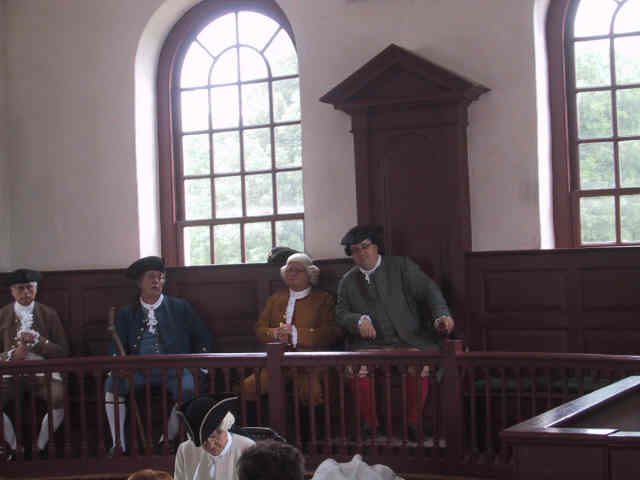
We all loved the shoemaker. We had spent quite some time with the
shoemaker in Old Salem, and did the same here. This man stuck Jody as
looking exactly like Gepetto.
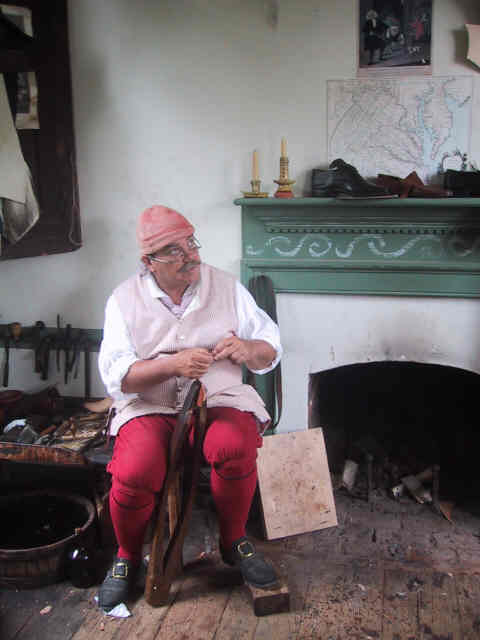
I took this odd and controversial shot, originally in color but processed by
me. It is controversial in that Jody does not much care for it, but I like
the sense of the blacksmith's movements, and the focus on the hot iron.
They are making a spade, which we later saw being delivered. We spent a
considerable time there, since one of the smiths was very talkative and offered
a lot of information about 18th century smithing and how it is currently
practiced.
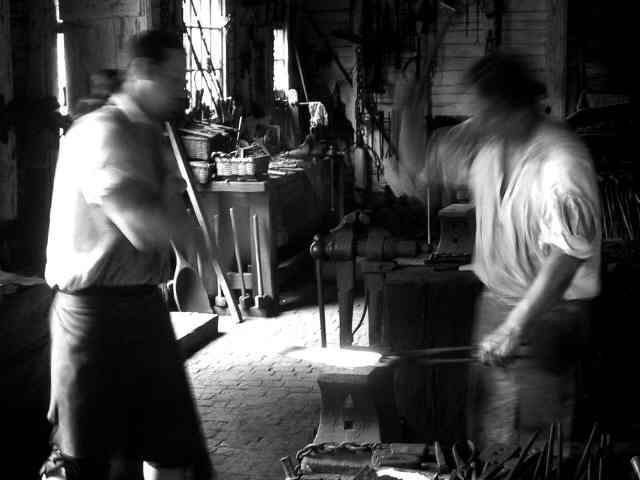
At the wigmakers. Only the wealthy could afford wigs (for both men and
women). They shaved their heads completely (again, women too), and often
had several different wigs from which to choose. A large, complex wig
could take 400 or so hours to complete, and was quite costly. Thus the
phrase "big wig". The most preferred wigs were made of imported
human hair, but yak, goat, and/or horse were also used. Multiple hair
sources were needed in order to create the color desired.
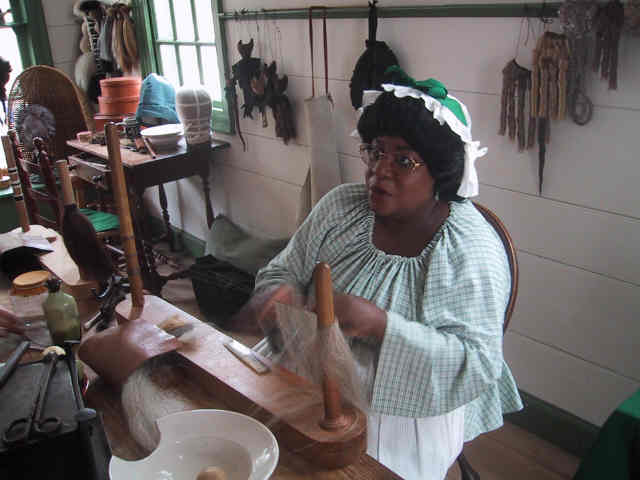
Cardinals have been abundant since we hit the Carolinas. I finally
managed to get close enough to one to snap this shot. The real-life reds
are even more brilliant than this.
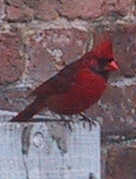
We sprang for dinner one night at one of the taverns, which all served
authentic 18th-century fare. This was really fun for us, but was way too
much food. This is a shot of Jody taken through a candle glass; she looks
a bit like a 'haint', 18th century slave patios for a ghost.
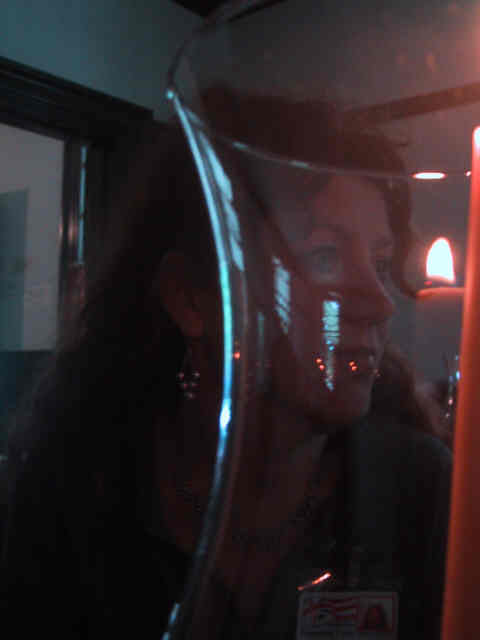
While Jody and I were watching an auction (some of us were inclined to
bid) being held near the middle of town, the girls made a new friend! His
name was Ryan, almost 8 months old.
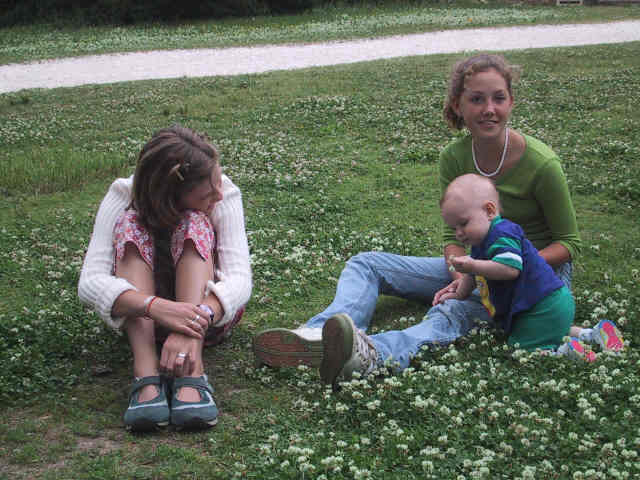
When we had last visited Williamsburg 6 years ago, one evening while
strolling about, we stumbled upon the brickmakers firing a large batch of 10,000
or so bricks, all to be used in restoration. So, we again sought them out,
only to find that they only fired bricks for one week a year -- we had arrived 6
years ago during that week. However, this time the brickmakers were
forming and drying this year's batch of 10,000, so we got to help out with
that. Below, the ladies are grooming the clay, just before it is pressed
into the molds. They were instructed to run it carefully through their
fingers, and to remove all roots, rocks, etc., so that only smooth clay remaind.
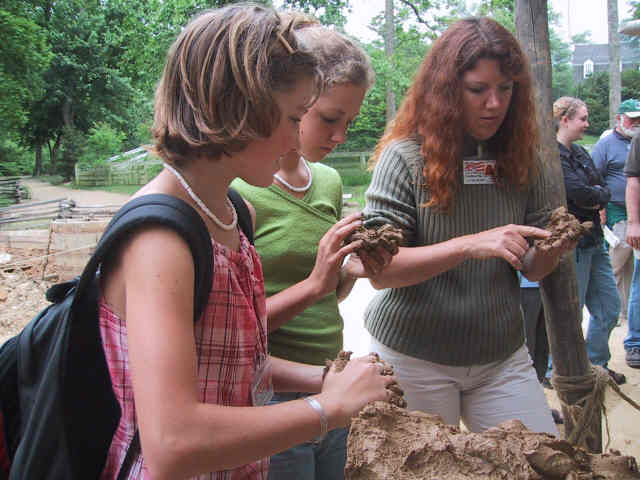
Jordan, being already barefooted, was invited to help mix the clay to the
proper consistency in the clay pit. Barrels of water were provided for
removing the very sticky clay from body parts.
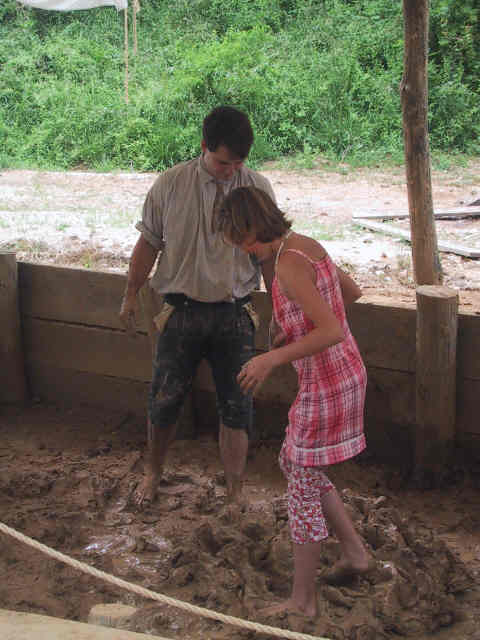
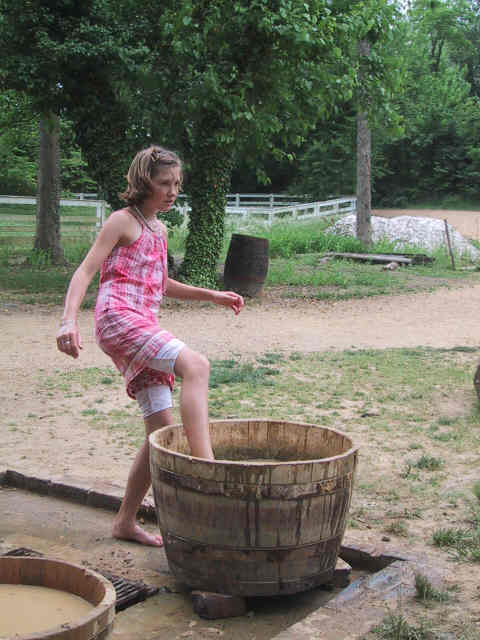
This grainy poorly exposed shot was taken using no flash, in the very dim
candle and lamp light of the tavern at night. At center right is David
Gardner, one of the pre-eminent fiddle players of the 21st century,
entertaining us in authentic 18th-century style.
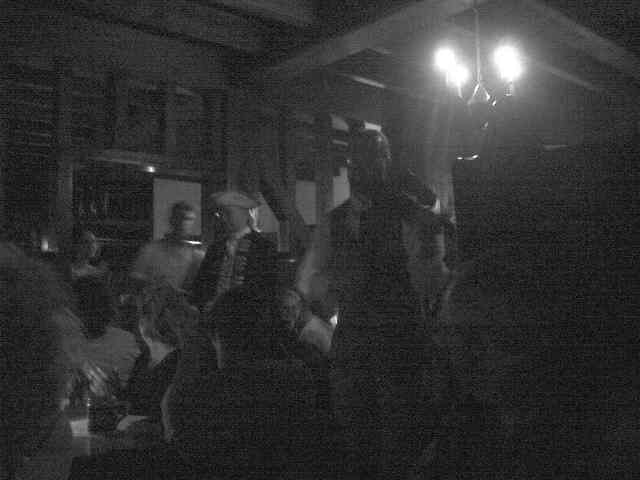
On our way out of Williamsburg, we stopped off at Carter's Grove, a restored
18th century plantation complete with slave quarters. Admission to
Carter's Grove is included in a Williamsburg ticket price.
As you can see, we have become fond of black and white shots. This
image is of the interior of a slave cabin. The pallet at rear is the 'bed'
-- a straw filled muslin bag. This one was on a rough-made pallet; most
lay on the bare dirt floor. The few articles of clothing a slave owned
were hung on pegs on the walls. Food preparation implements are in the
foreground, including a butter churn.
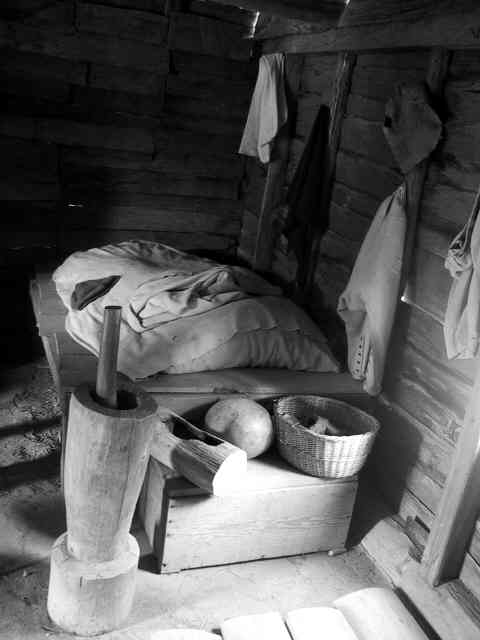
This is an exterior shot of a slave cabin. This was as nice as it got
-- the owner was the slave foreman, and so had a 'bought' bed, and the entire
cabin devoted to the one family. Usually each cabin held 2 or more
families.
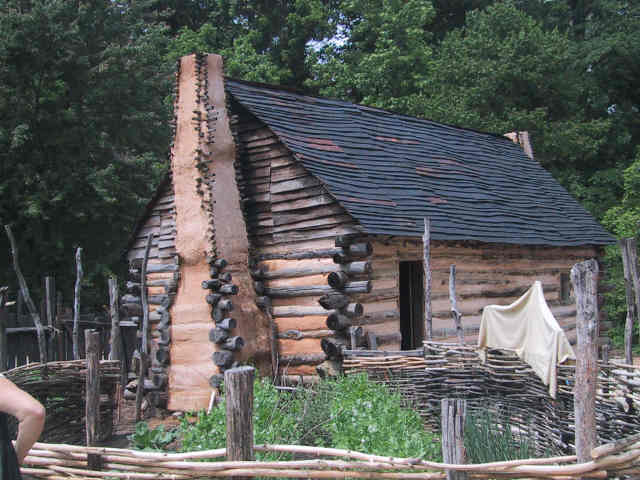
The woman pictured below created and performed the 19th century character
"Jinnie Joseph". She passionately told the story of how she was
sold away from her 4-year old daughter, but after emancipation went out to find
her -- which she did do, only to have the daughter not remember her and reject
her. It was very emotional.
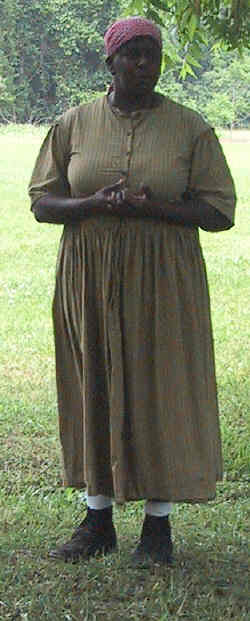
Also at Carter's Grove was a restored mansion. It had been restored to
its 19th century state, circa 1835. We had become 18th century snobs
though, and were not so very interested, but we took the tour. The kitchen
pantry was the highlight for us.
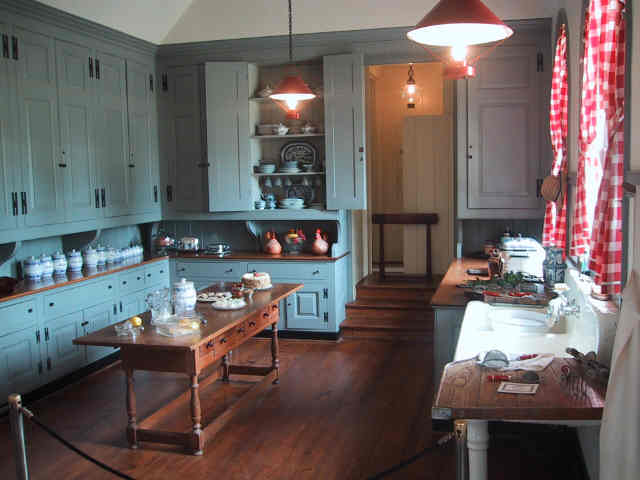
After leaving Carter's Grove, we continued driving, this time West (again!),
into the mountains, towards Monticello, Thomas Jefferson's home. We had
selected a KOA to stay at that night, as our options were rather limited.
We had been avoiding KOAs so far, since they tended to be sometimes pricey, and
often times devoid of any outdoor ambiance. This one surprised us on both
fronts, being very woodsy and quite reasonable. We unhitched and set up
just in time. It became unnaturally dark, and then I heard a noise in the
woods, like the leaves being rustled together -- or like humongous rain drops
falling in the trees. Within a minute a hellacious thunderstorm was on top
of us, dropping marble-sized raindrops, complete with bright lightening flashes
followed immediately by loud long rumbles. It was very fun and exciting,
as it was our first real East Coast thunderstorm. After only minute or
two, the power went out, apparently a victim of the storm, and stayed off until
after 10 PM. We can 'dry camp' pretty readily (no hookups) and so we did,
listening to and watching the storm, and playing cards. It was very cozy
and jolly.
May 23 - Monticello
![]()